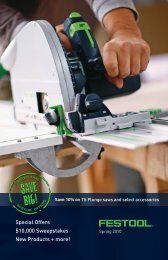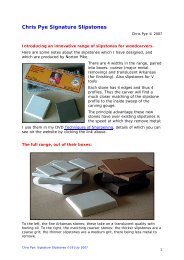Joiner and - Tools for Working Wood
Joiner and - Tools for Working Wood
Joiner and - Tools for Working Wood
You also want an ePaper? Increase the reach of your titles
YUMPU automatically turns print PDFs into web optimized ePapers that Google loves.
advantages <strong>and</strong> disadvantages of each approach.<br />
Thomas begins cutting the first joint by marking the baseline of the<br />
joint using a marking gauge set <strong>for</strong> the exact thickness of the joint. This,<br />
in <strong>and</strong> of itself, is an interesting detail. Modern woodworkers are mostly<br />
in two camps: Either set the gauge so it is a little wider or set the gauge<br />
so it is a little narrower than the thickness. If you set it wider, you’ll have<br />
some end grain to trim away to flush up your tails <strong>and</strong> pins after the joint<br />
is assembled. If you do it the other way, you’ll have some face grain to<br />
trim away instead.<br />
I’ve experimented with both perspectives (a lot) <strong>and</strong> they work.<br />
However, I like to do it the way Thomas does: Shoot <strong>for</strong> the exact<br />
dimension. You’re going to have to plane down the entire assembly<br />
anyway, so why make extra work <strong>for</strong> yourself on the pins or the tails?<br />
Then Thomas marks the pins on the end grain <strong>and</strong> the face grain <strong>and</strong><br />
saws them out. I, however, take an additional step. I plane the shallowest<br />
rabbet possible on the inside edge of my tailboards. This rabbet is as<br />
wide as my stock is thick. And the rabbet is about 1/64" deep. This little<br />
rabbet makes it easier <strong>for</strong> me to transfer the marks from one board to<br />
another when I am marking out the second half of the dovetail joint.













